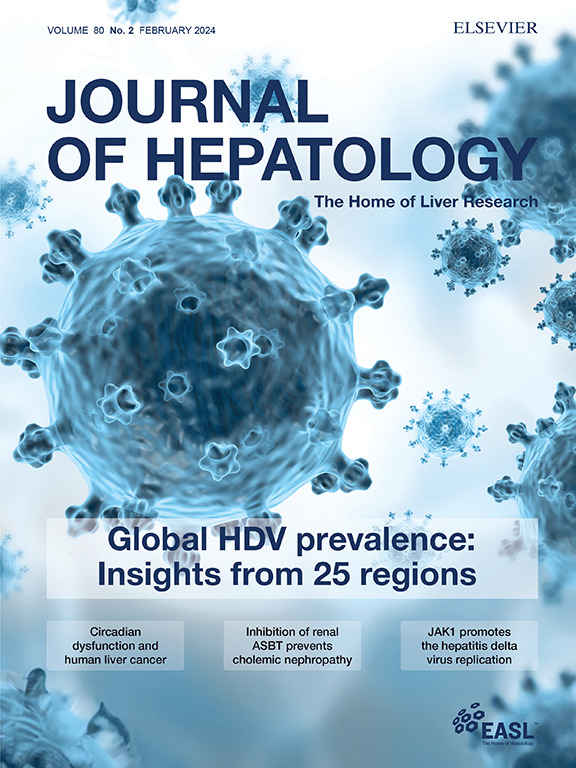实现乙型肝炎的功能性治愈:联合疗法是关键吗?
IF 26.8
1区 医学
Q1 GASTROENTEROLOGY & HEPATOLOGY
引用次数: 0
摘要
背景和背景慢性乙型肝炎病毒(HBV)感染是一个主要的健康负担,据估计,世界上3%的人口患有慢性感染受感染的个体有发展为慢性肝病导致肝硬化、肝脏相关并发症和发展为肝细胞癌(HCC)的风险用核苷类似物(NA)进行抗病毒治疗可有效抑制HBV DNA复制,从而降低患者疾病进展和HCC发展的风险。目的、方法和发现在《新英格兰医学杂志》上发表的一项II期研究中,160例慢性HBV感染并已确定有效NA治疗且无临床显著纤维化或肝硬化的患者被随机分配接受(A) xalnesiran 100 mg或(B) 200 mg。(C) xalnesiran 200 mg + ruzotolimod 150 mg, (D) xalnesiran 200 mg +聚乙二醇化干扰素α (PEG-IFN),在继续NA治疗的基础上,或(E)单独NA研究结果的意义本研究表明,在继续NA治疗的基础上,小干扰RNA (xalnesiran)和免疫调节剂(ruzotolimod或PEG-IFN)联合治疗可导致相当比例的患者HBsAg损失。有趣的是,与TLR7激动剂ruzotolimod相比,接受PEG-IFN治疗的患者的反应率更高。这些差异的原因尚不清楚,但可能是由于IFN更广泛的免疫调节活性,这影响了财政支持。作者没有获得任何财政支持来撰写这篇论文。利益冲突本研究的作者声明他们没有任何利益冲突。详情请参阅随附的ICMJE披露表格。本文章由计算机程序翻译,如有差异,请以英文原文为准。
Toward functional cure of hepatitis B: Is combination therapy the key?
Section snippets
Background and context
Chronic hepatitis B virus (HBV) infection is a major health burden and it is estimated that 3% of the world’s population are chronically infected.1 Infected individuals are at risk of developing chronic liver disease leading to cirrhosis, liver-related complications and development of hepatocellular carcinoma (HCC).2 Antiviral treatment with nucleos(t)ide analogues (NA) effectively suppresses HBV DNA replication thereby reducing the risk of disease progression and HCC development in patientsObjectives, methods and findings
In the phase II study published in the New England Journal of Medicine, 160 patients with chronic HBV infection and established effective NA treatment without clinically significant fibrosis or cirrhosis were randomly assigned to receive (A) xalnesiran 100 mg or (B) 200 mg, (C) xalnesiran 200 mg plus ruzotolimod 150 mg, (D) xalnesiran 200 mg plus pegylated interferon alfa (PEG-IFN), all in addition to continued NA treatment, or (E) NA alone.9 The total treatment duration was 48 weeks in allSignificance of findings
This study demonstrated that combination treatment with a small-interfering RNA (xalnesiran) and an immune-modulatory agent (ruzotolimod or PEG-IFN) in addition to continued NA treatment led to HBsAg loss in a substantial proportion of patients. Interestingly, response rates were higher in patients receiving PEG-IFN compared to the TLR7 agonist ruzotolimod. The reasons for these differences are unclear but could be due to the broader immunomodulatory activity of IFN, which affects both theFinancial support
The authors did not receive any financial support to produce this manuscript.Conflict of interest
The author of this study declares that they do not have any conflict of interest.Please refer to the accompanying ICMJE disclosure forms for further details.求助全文
通过发布文献求助,成功后即可免费获取论文全文。
去求助
来源期刊

Journal of Hepatology
医学-胃肠肝病学
CiteScore
46.10
自引率
4.30%
发文量
2325
审稿时长
30 days
期刊介绍:
The Journal of Hepatology is the official publication of the European Association for the Study of the Liver (EASL). It is dedicated to presenting clinical and basic research in the field of hepatology through original papers, reviews, case reports, and letters to the Editor. The Journal is published in English and may consider supplements that pass an editorial review.
 求助内容:
求助内容: 应助结果提醒方式:
应助结果提醒方式:


